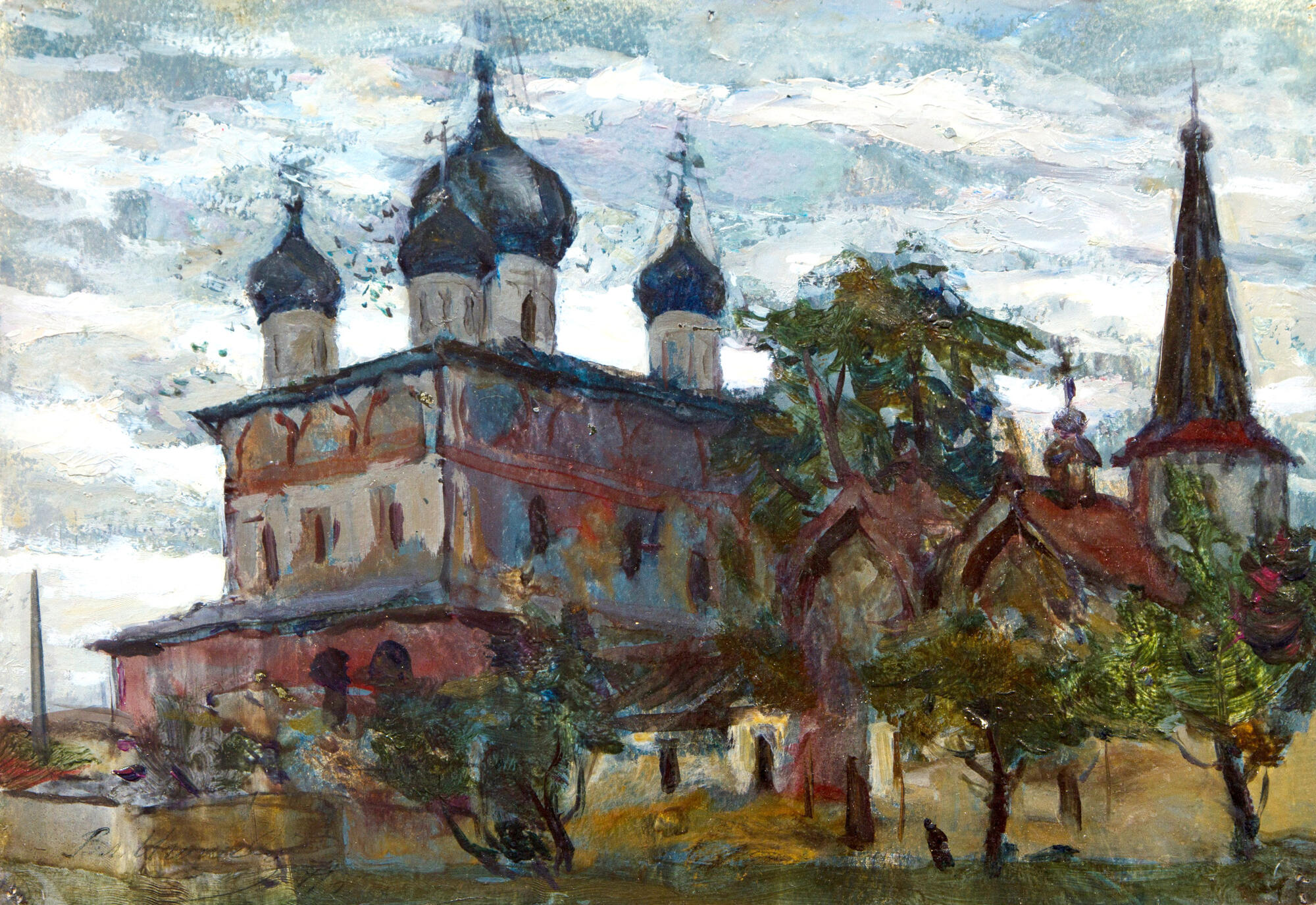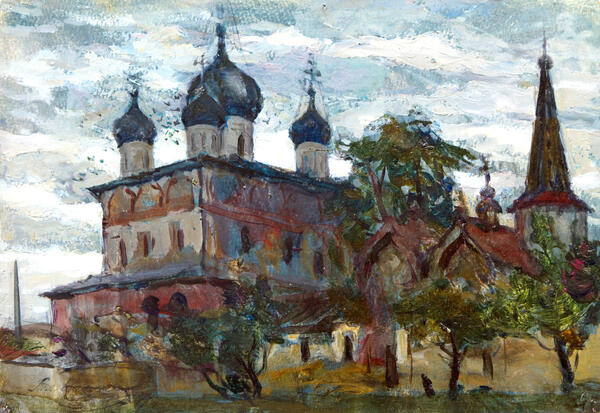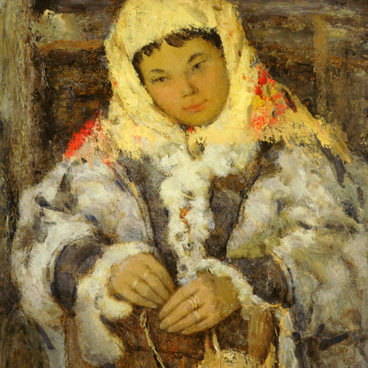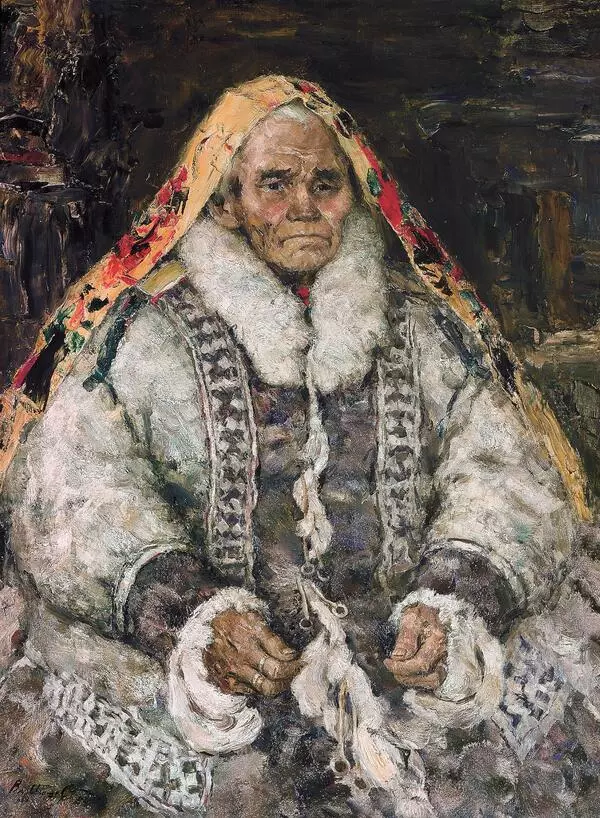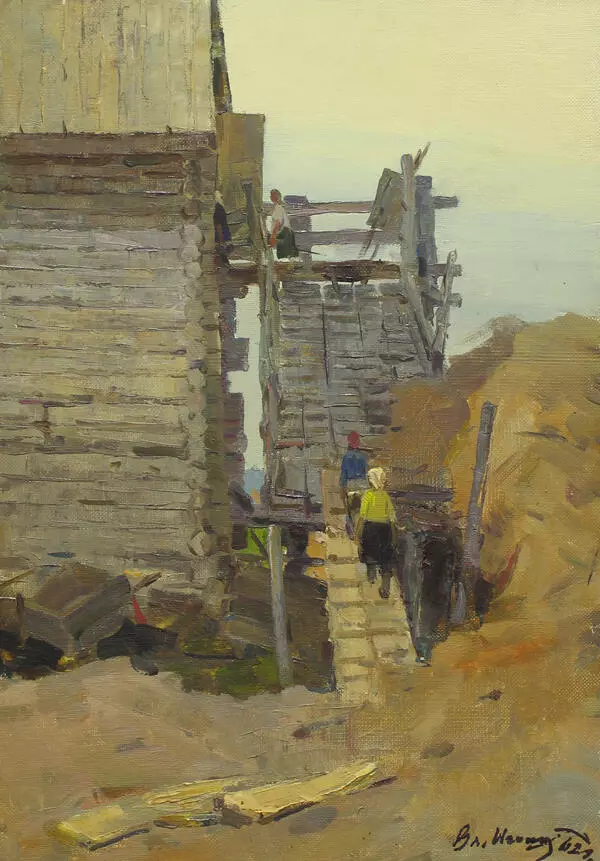Vladimir Igoshev painted the Znamensky Cathedral in Novgorod in 1971.
In the life of the old cities the cathedrals weren’t only of religious significance. Their appearance embodied the power and glory of the city and the splendor of its prince. They were supposed to fascinate their contemporaries and become the significant sites for years to come.
The construction of the Znamensky Cathedral started in 1682 in the territory of the demolished Znamensky church of the 14th century. The church rose above the wooden cottages, shining with its golden domes. Its bell-ringing was heard all around the district. It is a five-domed cathedral typical for the Central Russian architecture of the 17th century. The building was constructed with high ground floor and a two-storey gallery.
The front sides have pilasters and are completed with the false zakomaras decorated with paintings. In the Russian architecture zakomar is a semicircular or keeled completion of a curtain wall, reproducing the adjacent to the inner vault. False zakomar, which is not repeating the inner shapes of the vault, is called the kokoshnik. Kokoshniks were only made as decorative elements. They were placed on the walls and vaults, as well as the shrinking tiers at the base of the tents and dome drums in Church buildings.
The temple was decorated with an ornamented band typical for the architectural monuments in Moscow and Kostroma. The windows were framed with platbands made of brick. The old glazed tiles can be seen in the front of the temple. The cathedral was rebuilt many times and didn’t preserve its initial look.
The cathedral was dedicated to Our Lady of the Sign icon. In the Orthodox Church it is considered one of the most revered icons. The feast dedicated to the icon is celebrated on November 27th. It was initiated by archbishop John in the 12th century.
In 1354 the icon was transferred to the Temple of the Sign Icon of the Mother of God, which was burnt down by order of archbishop Moses. In 1560 the icon was transferred to the Church of the Transfiguration of the Savior on Ilyina Street, and afterwards it was moved to the Znamensky Cathedral in Novgorod.
In the life of the old cities the cathedrals weren’t only of religious significance. Their appearance embodied the power and glory of the city and the splendor of its prince. They were supposed to fascinate their contemporaries and become the significant sites for years to come.
The construction of the Znamensky Cathedral started in 1682 in the territory of the demolished Znamensky church of the 14th century. The church rose above the wooden cottages, shining with its golden domes. Its bell-ringing was heard all around the district. It is a five-domed cathedral typical for the Central Russian architecture of the 17th century. The building was constructed with high ground floor and a two-storey gallery.
The front sides have pilasters and are completed with the false zakomaras decorated with paintings. In the Russian architecture zakomar is a semicircular or keeled completion of a curtain wall, reproducing the adjacent to the inner vault. False zakomar, which is not repeating the inner shapes of the vault, is called the kokoshnik. Kokoshniks were only made as decorative elements. They were placed on the walls and vaults, as well as the shrinking tiers at the base of the tents and dome drums in Church buildings.
The temple was decorated with an ornamented band typical for the architectural monuments in Moscow and Kostroma. The windows were framed with platbands made of brick. The old glazed tiles can be seen in the front of the temple. The cathedral was rebuilt many times and didn’t preserve its initial look.
The cathedral was dedicated to Our Lady of the Sign icon. In the Orthodox Church it is considered one of the most revered icons. The feast dedicated to the icon is celebrated on November 27th. It was initiated by archbishop John in the 12th century.
In 1354 the icon was transferred to the Temple of the Sign Icon of the Mother of God, which was burnt down by order of archbishop Moses. In 1560 the icon was transferred to the Church of the Transfiguration of the Savior on Ilyina Street, and afterwards it was moved to the Znamensky Cathedral in Novgorod.
